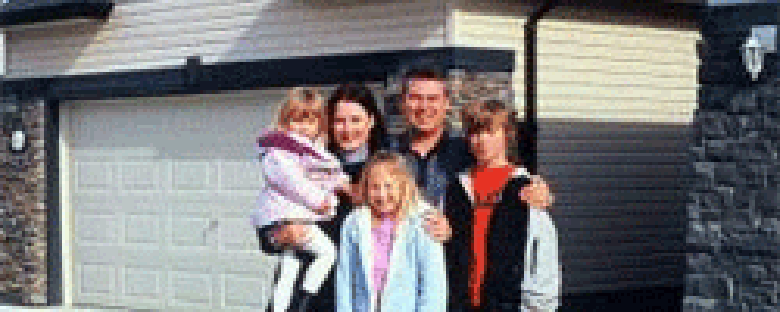Reviews
Jim Brown and Gary Burns
USA, 2006
Credits
Review by Adam Balz
Posted on 02 July 2007
Source 35mm print
A film’s genius can sometimes come from its finale: the mystery of Norman Bates’ mother, the location of Keyser Soze, the identity of Rosebud. A finale can also be a film’s downfall. But to approach the ending in discussion is to spoil the surprise. The review that follows contains a discussion of Radiant City’s conclusion, and should not be read by those hoping to savor its revelation.
The home should be the treasure chest of living.
—Le Corbusier
In 1947, a New York City insurance company named Levitt & Sons broke ground on simple, one-story housing units in Nassau County; the old land, once a large potato field and farmland, covered over 3500 acres of Long Island real-estate. Within a year, they offered these saltbox-esque homes for $60 a month, later offering them for immediate purchase. Intended to house veterans and their families, Levittown in New York is regarded as the nation’s first suburb, and almost immediately it was the focus of anger and disdain. In 1951, critic Cyril Connolly said, “Slums may well be breeding-grounds of crime, but middle-class suburbs are incubators of apathy and delirium.” In 1961, Lewis Mumford condemned the American suburb, specifically Levittown, for its preference of homogeny in look and class and income over individuality; suddenly, he said, people were sitting in the same blueprinted rooms, eating the same microwave-tray dinners, discussing the same television shows. And in 1980, Charles Haar wrote that “Suburbs…have become the heirs to their cities’ problems. They have pollution, high taxes, crime. People thought they would escape all those things in the suburbs. But like the people in Boccaccio’s Decameron, they ran away from the plague and took it with them.” Fifty years later, Levittown had a population of over fifty-three thousand, was predominately white, and had a median family income of $73,851. And while the ideals associated with the American suburb persist, it is under almost constant scrutiny.
Radiant City opens with a child’s-eye view of Evergreen, an emerging suburb in Toronto. Having scaled a telephone tower, Kyle Moss concentrates his handheld camera on the sprawling development below. His home, he tells us, is somewhere amongst the menagerie of exposed lumber and drywall and shingling. Later, he introduces us to his sister on the front lawn of their home, as well as a waist-high power-box, the danger of which both seem to take with some humorous indifference.¬†Kyle’s parents, Evan and Ann, are seeking a warm family life in Evergreen, even as he spends two hours each morning in traffic on the way to work and she struggles to find comfort in a home of her dreams. Late in the film, she introduces us to the original Moss home—a small, upper-story apartment overlooking the cold, lifeless gray of the urban landscape. When the Evergreen community theatre troupe stages Surburbs: The Musical, a satirical production Evan finds on the Internet, Ann stages an on-camera rant against her husband.
Interspersed with footage of Evan Moss driving to work or Kyle playing with his friends are interviews with noted academics—historians, architects, urban planners, all of whom express their deep displeasure and frequent resentment with contemporary suburbs. They are too impersonal, too far from shopping centers, too economically impractical; they result in a waste of natural resources, a relinquishing of good health, the ruin of community; they are a catalyst for disaster. In one instance, an author and opponent walks a designated nature trail, which shadows a teeming interstate; instead of wild animals and thickets of trees, there is a lone park bench and miles of chain-link fence.
Radiant City, which opens with a quote from famed architect Le Corbusier, also derives its title from his 1935 book of the same name. Peppered with exclamatory, one-word sentences like “Conscience” and “Liberty!” and “Fraternity!”, Corbusier’s work expounds on the belief that suburbs should foster and embody uniqueness, an appreciation and respect for nature, an availability to all. Suburbs should encourage community, should change with the size of the family, should abandon the look and feel of the city. But the phrase “radiant city” is used ironically by Brown and Burns to skewer ideals about modern urban sprawl. It’s clear the directors feel that contemporary suburbs in Canada and the United States have bastardized the bland, one-dimensional intentions of both Corbusier and Levitt. They have become expensive, available almost exclusively to upper-class whites; their look—the garage prominent towards passers-by, the backyard hidden behind fencing—gives a feeling of isolation and discontentment; they destroy nature rather than adapt to it; they distance people from commerce and industry and education. And with names like Nottingham and Canterbury Fields, they are the epitome of cookie-cutter frontages for unhappiness.
But you can’t discuss Radiant City without mentioning the last ten minutes, in which the “secret” of the Evergreen residents is revealed. The Moss Family is, in fact, not a family, but a collection of actors, as are their neighbors and friends; this is a mockumentary, albeit an expertly constructed one. (The only “true” participants in the film are a handful of civil servants and the half-dozen interviewees.) The only requirement of these performers, we’re told, is that they had to live in the suburbs; and, in the post-revelation interviews, some seem to enjoy their current homes, while others express a thin sense of despondency. A clever trick, though some may argue it cheapens the filmmakers’ purpose—by not depicting a true suburban family, Brown and Burns are exposing their biases, are reducing 86 minutes of arguments to a stage show with facts and professional opinions disguised as theatre. But in reality this decision does more to heighten their aims than anything else, as it highlights the overall discord concerning suburbs: It’s all fake.
We don’t do comments anymore, but you may contact us here or find us on Twitter or Facebook.



